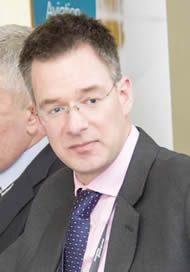|
The arrival of commercial Single Engined IFR operations in Europe would be a shot in the arm for our industry, says Oriens Aviation CEO Edwin
Brenninkmeyer.
Chairing a panel session at last week's BBGA Conference for General and Business Aviation, Brenninkmeyer took the opportunity to share important news that Geoff Parker, head of the
UK CAA flight operations policy, had already held two public meetings with EASA and advised that the CAA would use its 'exemptive powers' to allow such flights by as early as October
this year.
|
"It is not a question of if, but when," he said, adding that operators can seize the EASA endorsement to prepare manuals for approval in readiness for public charter flights.
Eurocontrol is already working on developing new low level routes to accommodate these aircraft, noted AOPA UK CEO,
Martin Robinson.
"This is just what this stagnant market needs," echoed WINGX Advance Managing Director
Richard Koe who said the market for aircraft like the Cirrus, Socata TBM and PC-12 has seen
a 16% compound annual growth rate this last decade. There are around 2,000 such aircraft in service active in Europe - almost all flying privately - with the PC-12 the most popular.
"North America has a vastly more active market, with a large number of charter and fractional operations based on single engine fleets. The proven appeal of these aircraft,
|
 |
| Edwin Brenninkmeyer. |
| with their great
operational versatility and low pricing, is just the sort of opportunity which online brokerage disruptors like StrataJet should want to exploit in Europe," he added. |
At London Oxford Airport, the UK's sixth ranked business aviation airport, there has been a marked increase in users of business turboprop and piston engined aircraft flying as operators
like to keep their costs tight.
 |
Business Development Head James Dillon-Godfray suggested these aircraft would be ideal for the tedious 200-300 mile journeys where the car journey is too long and the train service
is not direct - and typically very expensive. They would also suit shuttle services for corporates who want to get to their factories a few times a week, he said.
The Cessna Caravan, a regular at Oxford mainly performing cargo flights, is good for road or train trips that would normally take up to four hours and the Pilatus PC-XII flying at up to
300mph (285 kts), for those journeys that by ground transportation take four hours plus. The Caravan can fly at 200 mph and can certainly beat a UK four-hour train journey in terms of
costs per seat mile. Likewise, the PC-XII hits its economical sweet spot on trips from, say, Oxford to Edinburgh or Paris. "This could be a real transformation for our industry," he said,
adding these aircraft could breed a new range of mini-FBOs at smaller general aviation airports.
|
| WINGX Advance Managing Director, Richard Koe. |
Neil Harvey, Director of Hunt and Palmer said this could be a sea change in the perception of turboprop aircraft. The King Air for example is harder to sell against a small jet - and when
charters are booked it's usually for under four passengers. New aircraft will definitely help the jet vs. turboprop argument.
But would smaller operators flying King Airs or VLJs have to lower their charter rates to compete with this new model?
The panel thought no; and it would be foolish for them to lower their prices to compete. Rather, this will open a new entry level layer. This is the nursery for business aviation, suggested
Richard Kearsey from Close Bros.
Christopher Mace from Saxon Air added: "It won't work for everyone, but entry level jet charter is faring well and [is] popular. New single engined jets for public charter is going to bring a
few more AOC operators to the scene."
"Our industry has always stood out as entrepreneurial," said Gama Aviation CEO
Marwan Khalek, whose own business started in 1983 out of Fairoaks Airport with a Beech Baron. "If it
brings new entrants in, it can only be a good thing," he said.
But what are the restrictions on single-engined ops across the sea? or the licensing of small airports to handle such aircraft? If there are a raft of restrictions the proposition becomes less
attractive. Brenninkmeyer advised that the current proposals are all listed on the EASA website.
(www.easa.europa.eu).
Andy Patsalides, Head of Marketing at London Biggin Hill Airport remarked that the savvy, younger generation, would embrace this model and kick-start the industry. "It will be a godsend
at Biggin Hill," he said.
|